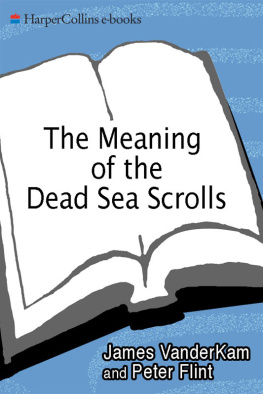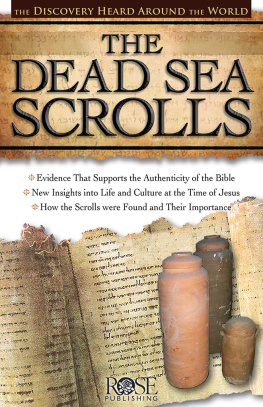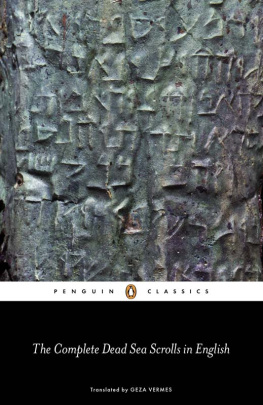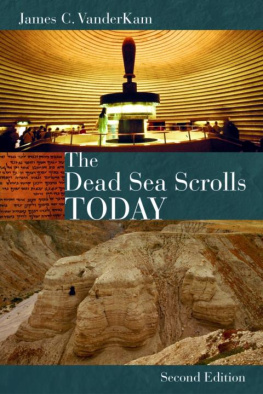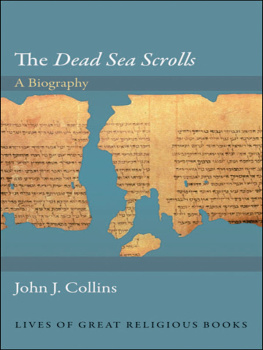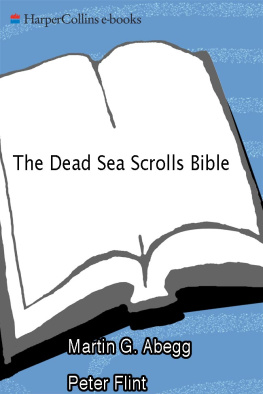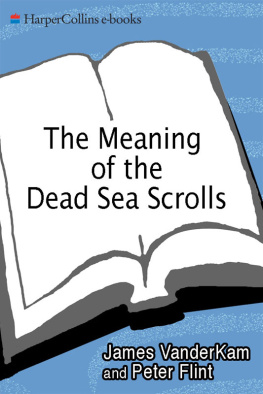Contents
BY EMANUEL TOV
Discoveries, Dating, Archeology, and New Methods
. The Discovery of the Dead Sea Scrolls
. Dating the Dead Sea Scrolls
. Archeology of the Qumran Site
. Technology and the Dead Sea Scrolls
The Dead Sea Scrolls and Scripture
. The Hebrew Bible/Old Testament Before the Scrolls
. The Biblical Scrolls and the Text of the Hebrew Bible/Old Testament
. The Dead Sea Scrolls and the Canon of the Hebrew Bible/Old Testament
. Apocrypha and Pseudepigrapha in the Dead Sea Scrolls
The Nonbiblical Scrolls and Their Message
. A Survey of the Nonbiblical Scrolls
. Identifying the Group Associated with Qumran
. The Theology or Belief System of the Qumran Group
. The Qumran Group Within Early Judaism
. Biblical Interpretation in the Dead Sea Scrolls
The Scrolls and the New Testament
. Were New Testament Scrolls Found at Qumran?
. Jesus and the Dead Sea Scrolls: The Gospels and Qumran
. The Dead Sea Scrolls and Other New Testament Books: Acts and the Letters
. The Dead Sea Scrolls and the Book of Revelation
Controversies About the Dead Sea Scrolls
. Scroll Wars
. Index of Passages in the Biblical Scrolls from the Judean Desert
. Index of Passages from the Apocrypha and Pseudepigrapha in the Scrolls
. Quotations and Allusions in the Nonbiblical Scrolls
. Translations and Editions of the Dead Sea Scrolls
THE MEANING OF THE DEAD SEA SCROLLS: Their Significance for Understanding the Bible, Judaism, Jesus, and Christianity . Copyright 2002 by James VanderKam and Peter Flint. All rights reserved under International and Pan-American Copyright Conventions. By payment of the required fees, you have been granted the non-exclusive, non-transferable right to access and read the text of this ebook on-screen. No part of this text may be reproduced, transmitted, down-loaded, decompiled, reverse engineered, or stored in or introduced into any information storage and retrieval system, in any form or by any means, whether electronic or mechanical, now known or hereinafter invented, without the express written permission of HarperCollins ebooks.
FIRST HARPERCOLLINS PAPERBACK EDITION PUBLISHED IN 2004
Library of Congress Cataloging-in-Publication Data
VanderKam, James C.
The meaning of the Dead Sea scrolls: their significance for understanding the Bible, Judaism, Jesus, and Christianity / James C. VanderKam.1st ed.
p. cm.
Includes bibliographical references and indexes.
ISBN 006-0684658 (pbk.)
1. Dead Sea scrollsHistory and criticism. 2. Bible. O.T.Criticism, interpretation, etc. 3. Qumran community. 4. Dead Sea scrollsRelation to the New Testament. I. Flint, Peter W. II. Title.
BM487 .V27 2002
296.155dc21
20022069730
EPub Edition AUGUST 2013 ISBN: 9780062243300
06 07 08 RRD(H) 10 9 8 7 6 5
To Mary
To Amanda
SOON AFTER THEIR DISCOVERY IN 1947, THE DEAD SEA SCROLLS took the world by storm, and ever since scholars and general readers alike have studied them, read them, or at least talked about them. The first scrolls were published in 1950 in what we now consider primitive editions, but at least they were released; the delay in the publication process occurred only at a later stage. Together with these text editions we have been blessed, usually, by a veritable flood of studies on the Qumran community and individual scrolls. These studies elucidated the content of the scrolls and placed them in the context of the Jewish society and multifaceted literatures of the late Second Temple period. Diverse explanations of these scrolls abounded and theories multiplied, to the joy of researchers of antiquity and those involved in the history of research. However, the more scholars wrote, the greater the confusion grew among readers, and correspondingly the more a need was felt to pull the threads together. At that point, in the 1950s, the first introductions to the Dead Sea Scrolls started to appear; some of them were very impressive and remain so even today, especially those appearing in revised editions.
But as the task of an introduction is to provide a full picture of an area of research, and as this area has expanded many times over due to the recent flood of publications, especially over the last decade, the writing of a new introduction became desirable. Such an introductory volume covering the full range of data presented to the public up to 2002 is represented by this book by Professors James C. VanderKam and Peter W. Flint.
At this point, all the Qumran scrolls have been published in scholarly editions together with translations and extensive technical notes and elucidations of their content. A comprehensive concordance is scheduled to appear in the fall of 2002, and a one-volume edition of all the nonbiblical Dead Sea Scrolls is to follow shortly thereafter.
Early descriptions of the Qumran scrolls mentioned 600 manuscripts, a number that has grown in our imagination to 700, 800, 900, and now 931, according to my calculations of August 2002 based on the data included in the introductory volume to the Discoveries in the Judaean Desert series (vol. 39, Oxford: Clarendon Press, 2002). In ten cases these manuscripts contain different texts on their recto and verso. Early calculations were based on mere estimates, while recent ones followed inventory lists. However, any attempt to count these manuscripts is fraught with difficulties due to the fragmentary status of the corpus. As a result of these problems, the totals for the manuscripts are only approximate and the figure 931 has to be taken with a grain of salt. This number refers to texts of different length. Some are long or even very long, such as the large Isaiah scroll from cave 1 and the long copy of the Temple Scroll from Cave 11. Others comprise one-sheet compositions, such as 4QTestimonia and personal notes such as the Aramaic so-called 4QList of False Prophets and the Hebrew 4QList of Netinim , which were written on mere scraps of leather. The number of Qumran manuscripts is not identical to that of the compositions found in the caves, since many compositions are represented by multiple copies. If these multiple copies are deducted from the overall number of manuscripts, we are left with 445 items, including 175 unidentified fragments. Because of the many difficulties relating to the evaluation, we presume that the Qumran caves housed multiple copies of up to 350 independent compositions.
The Qumran library, quite sizable by ancient standards, was initially housed in the community buildings at Khirbet Qumran and later in the adjacent caves, which served as living and work quarters as well as storage areas. The compositions compose a heterogeneous corpus penned in Hebrew, Aramaic, and Greek consisting of various literary genres including not only the sectarian literature of the Qumran community, but also writings composed elsewhere in ancient Israel, including the much older biblical writings. Because of the diverse nature of the Qumran corpus, one cannot speak of a single discipline devoted to Qumran research, for such a discipline would, of necessity, have to include many subdisciplines; in addition to a thorough grasp of the different literary genres found at Qumran, a knowledge of the history of the Jewish people in the Second Temple period, the history of the Hebrew and Aramaic languages, archeology, the history of ideas, and the background of Christianity would all be necessary. The study of the Qumran documents thus involves various disciplines, all of which are covered by this volume.

